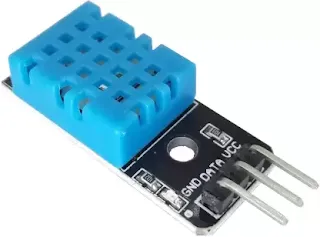Introduction
A calibrated digital signal output is provided by the temperature and humidity sensor complex of the DHT11 device. By utilising the unique digital-signal-acquisition approach and temperature & humidity sensing technology, it ensures excellent dependability and good long-term stability A resistive humidity measurement is included in this sensor.
a high-performance 8-bit microprocessor, providing great quality, quick response, and interference resistance. It also links to an NTC temperature measurement component. cost-effectiveness and competence.
Each DHT11 component is meticulously calibrated in a humidity calibration lab that is exceptionally accurate. The calibration coefficients are used by the sensor's internal signal detecting process and are stored as programmes in the OTP memory. System integration is quick and simple thanks to the single-wire serial interface. It is the finest option for a variety of applications, including those that are the most demanding, because to its small size, low power consumption, and up to 20-metre signal transmission. The component is packaged with a single row of four pins. The ability to connect is simple, and users can request certain packages.
How does DHT11 Measure Humidity and Temperature?
A humidity sensor and a thermistor are both found inside the DHT11.
Two electrodes with a moisture-holding substrate sandwiched between them make up the humidity sensor component.
As water vapour is absorbed by the substrate, ions are released by it, increasing the conductivity between the electrodes.
As water vapour is absorbed by the substrate, ions are released by it, increasing the conductivity between the electrodes.
An NTC/Thermistor is also included in DHt11 to measure temperature. The resistance of a thermistor, a type of thermal resistor, fluctuates significantly with temperature. NTC stands for "Negative Temperature Coefficient," which denotes that resistance lowers as temperature rises.
An 8-bit SOIC-14 packed IC is located on a tiny PCB that is on the opposite side. This IC measures and processes the analogue signal using calibration coefficients that are stored converts the signal from analogue to digital and then outputs a digital signal that includes the temperature and humidity.
Parts of DHT11
The digital temperature and humidity sensor, model DHT11 from AOSONG, is the brain of the module.
DHT11 Sensor
The DHT11 can measure humidity from 20 to 80% with a 5% accuracy range and temperature from 0 to 50°C with an accuracy of 2.0°C.
The DHT11's sampling rate is 1Hz, thus you can obtain fresh data from it once every second.
Supporting Circuitry
The module should be able to function without any additional components because it has all the necessary supporting circuitry.
For proper communication between the DHT11 sensors and the Arduino, an extra pull-up resistor of 10K is typically required between the VCC and Out pin. You do not need to install a pull-up resistor because one is already present in the module.
A decoupling capacitor is also included in the module to filter power supply noise.
Pinout of DHT11 Sensor
Connecting the DHT11 module is not too difficult. Only three pins are present.
VCC - The sensor is powered by a pin. Although the supplied voltage ranges from 3.3V to 5.5V, a 5V supply is advised. You may keep the sensor for up to 20 metres with a 5V power source. However, the wire length for 3.3V supply voltage must not exceed 1 metre. Otherwise, measurement inaccuracies will result from the line voltage decrease.
OUT - To communicate between the sensor and the Arduino, the pin is utilised.
GND - should be plugged into Arduino's ground.
DHT11 Sensor specifications
- Resolution:16Bit
- Repeatability:±1%RH
- Accuracy:25℃ ±5%RH
- Interchangeability: Fully interchangeable
- Response time:1/e (63%)25℃ 6s1m/s Air 6s
- Hysteresis:<±0.3%RH
- Long-term stability:<±0.5%RH/yr
- Temperature
- Resolution:16Bit
- Repeatability:±1℃
- Accuracy:25℃ ±2℃
- Response time:1/e (63%) 10S
- Power supply: DC 3.3~5.5V
- Supply current: Measure 0.3mA Standby 60μA
- Sampling period: Secondary Greater than 2 seconds
DHT11 Sensor layout
Application of DHT11 Sensor
This sensor is employed in a number of applications, including the measurement of temperature and humidity levels in HVAC systems. These sensors are also used by weather stations to forecast the weather. In houses where residents are susceptible to the effects of humidity, the humidity sensor is employed as a preventative measure. This sensor is used in offices, vehicles, museums, greenhouses, and businesses to measure humidity levels and as a safety precaution.
This sensor is well-liked among hobbyists because of its small size and fast sampling rate. DHT22, AM2302, and SHT71 are a few of the sensors that can be utilised as an alternative to DHT11 sensors. Which DHT11 sensor specification was useful for your application?











